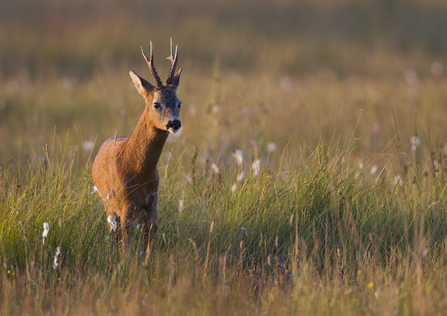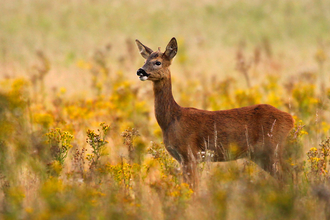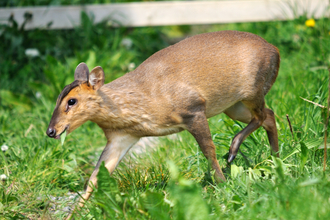My first few encounters with roe deer (Capreolus capreolus) were brief; just a glimpse of them bounding away from a hiding place, having been inadvertently disturbed by my approaching footsteps through the woods. Those glimpses were always in Wales or Scotland, but in Shropshire, it was actually fallow deer that I saw more frequently. Fallow deer (Dama dama) are slightly larger deer, with impressive antlers that can grow up to 80cm in height, but they are actually a non-native deer species in the county. Preferring life as part of a herd, fallow deer groups have regularly been observed around the Wrekin Forest for decades. Groups can number dozens and at a glance as I have been driving in the vicinity of The Wrekin, I have often mistaken them for herds of domestic cattle! The fallows have spread across the UK after introductions of the species during the Roman occupation of Britain, then later by the Normans around the 1100s. Many have also escaped from deer parks, where they were kept as part of prized exotic collections.
Back to roe deer; one of only 2 native deer species to the UK (the other being the red deer) and we are talking about another animal that has been greatly impacted by the activities of mankind. Roes have been present in the UK for over 6000 years, thriving in the once-abundant woodland that covered over half of our island. But their numbers were dwindling by the 18th century, due to over-hunting for food and the destruction of 1000s of square miles of woodland. During the Victorian period, roe deer from northern and western Europe were released in the UK to bolster numbers and reverse their decline. At the same time, more woodland was planted. Not necessarily for wildlife conservation purposes, but to make more land available in hunting, which increased in popularity in the 1800s.
Closer to home, roe deer are now present across woodlands in much of the county, with the Shropshire Hills and western parts of the county being well populated. Mysteriously, for many years, there has been a geographical gap in roe deer records in the area between Wem and Bronington (just over the border in Wrexham Borough) and the species don't seem to fare well in that location. But elsewhere in the county, roe numbers have significantly increased in recent years. My camera traps record roe deer in most of the areas that I install them and I now regular see them when I am out walking in woods. On one encounter, I was frightened to death as I was setting up a camera trap on a tree adjacent to a thicket of shrubs as I was interrupted by the sound of a hidden heavy animal crashing through the undergrowth directly towards me. As I turned to face the oncoming creature, cowering back against the tree, a large male roe buck emerged from the cover at full pace a few metres in front of me, continued straight towards me, then, realising that there was human in his tracks, dodged slightly to the side and brushed past me as he continued his escape from whatever it was that disturbed him. Not all encounters are as dramatic and you are much more likely to see a roe deer running away from you, rather than towards you!
Where to go roe spotting in Shropshire
Any area of woodland cover around the Shropshire Hills AONB and the Oswestry Hills is likely to be home to roe deer, but it often takes patience (and luck) to get into the position of being able to observe them. As creatures of habit, roes tend to follow well-established trails repeatedly and regularly return to areas with good grazing potential in glades and at woodland edges. But they are generally quite solitary and nomadic, so it could often be a few days in between visits to the same spots. To increase my chances of seeing them, I usually look for the clearest trails through undergrowth and search for signs of their scat (droppings - which are shiny oblong pellets around 0.8cm in length). Then check wind direction (make sure the wind is blowing towards you from the trail) and position yourself against a tree with some camo netting covering any skin, which is usually one of the first things that draws their attention. Then quietly sit and wait. And relax to the sounds of the forest, remembering that even if you don't see a deer, time spent in the woods is good for your health.
Some quick roe deer facts:
- Male roes are called bucks and females are called does, young are fawns (Bambi was originally based on roe deer)
- They grow up to 0.75 in height
- Only males have antlers, which are short and straight compared to fallow and red deer
- Roe deer moult their coat after winter. Their thick winter coat often makes them appear larger than they are in summer
- In spring, buck antlers go into a velvet stage, which is a development/growth phase of their antlers
- Roes live for an average of 10 years in the wild
- Loved by many people, roe deer can also have a negative impact on woodland flora when their numbers increase dramatically as they can overgraze and kill off ground covering plants
- There are now more non-native deer species living in the UK than native species: fallows, plus Chinese water deer, sika deer, and Reeves' muntjac Deer






